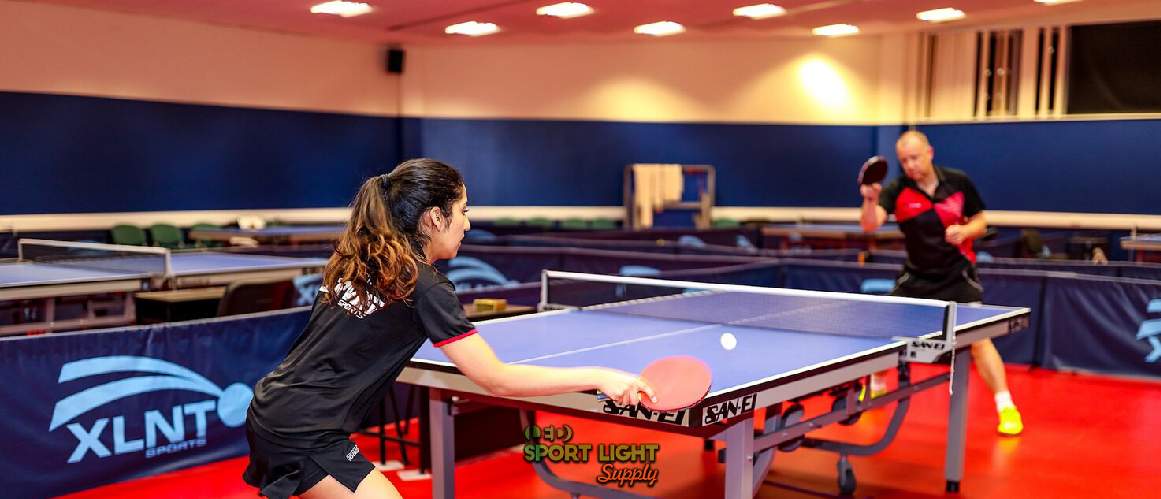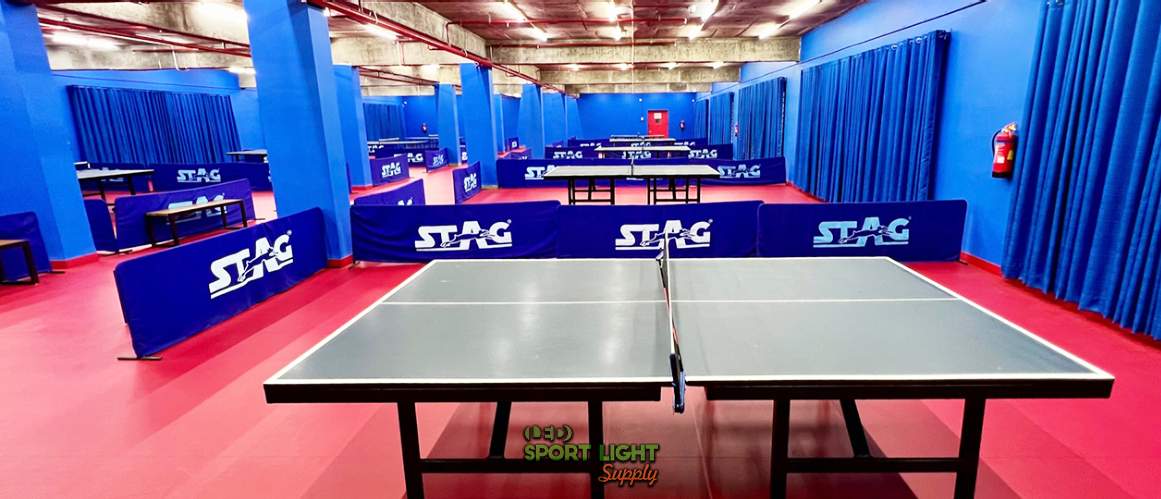Lighting is a critical element in the design of any sports facility, and the table tennis court is no exception. As the speed and precision of the game demand an optimal visual environment, the importance of specialized lighting cannot be overstated.
Table tennis, also known as ping-pong, is a game of reflexes and agility, played at high speeds. For players to perform their best, they need consistent and clear visibility of the ball at all times. The swift movements and rapid exchanges require lighting that minimizes shadows, reduces glare, and provides uniform brightness across the court. A well-lit environment not only enhances player performance but also improves spectator experience, making it a crucial aspect of any table tennis venue.

Table of Contents
ToggleAchieving the right level of brightness is one of the most critical aspects of table tennis court lighting. The recommended illuminance for a table tennis court is typically around 300 to 500 lux. This level of brightness ensures that players can see the ball clearly and react swiftly. Consistent lighting across the entire court is essential to avoid areas of varying brightness that could affect gameplay.
Uniformity in lighting is crucial to avoid shadows and bright spots that can distract players and impact their performance. LED fixtures with wide beam angles and advanced optical designs help distribute light evenly, reducing shadows and ensuring that every part of the court is equally illuminated. Addressing glare is also important; high-intensity lights can produce uncomfortable glare, which can hinder players’ ability to see the ball and concentrate. LED lights with diffused lenses and glare-reducing features can help mitigate this issue, providing a comfortable and visually conducive environment.
The color temperature of lighting plays a significant role in table tennis courts. A color temperature of around 4000K to 5000K is ideal for sports environments as it provides a neutral white light that enhances visibility without distorting colors. This range helps players distinguish the ball against the background and improves overall clarity.

Designing the lighting layout for a table tennis court involves careful planning to ensure that all areas of the court are properly illuminated. Lights are typically installed above the court, with fixtures positioned around the perimeter or mounted on the ceiling. For indoor courts, a grid of LED fixtures can be used to cover the entire playing area. The spacing of the fixtures should be calculated to achieve the desired lux levels and uniformity. Fixtures should be positioned at a height that provides sufficient illumination without causing direct glare to players.
In multi-purpose facilities where table tennis courts are used alongside other sports or activities, the lighting design should be adaptable. Adjustable LED fixtures and intelligent lighting control systems can provide the flexibility needed to switch between different lighting configurations based on the activity being conducted.
Effective lighting controls and automation are essential for optimizing the lighting environment in a table tennis court. These advanced systems not only enhance energy efficiency but also improve player experience by adapting to various needs and conditions.
Smart lighting systems offer a range of features designed to provide flexibility and efficiency. Motion sensors are a key component, detecting the presence of players and adjusting the lighting accordingly. In a table tennis court, these sensors ensure that lights are activated when the court is in use and turn off or dim them when not needed. This approach helps conserve energy and extends the lifespan of the lighting fixtures. Another useful feature is daylight harvesting, which adjusts the artificial lighting based on the amount of natural light available. Although table tennis courts are typically indoors, facilities with windows or skylights can benefit from this feature by reducing the need for artificial lighting during daylight hours. Additionally, dimmer controls allow for the adjustment of light levels based on specific needs. For instance, lower light levels might be sufficient during practice sessions, while full brightness is required for tournament play. Adjustable lighting provides the flexibility needed to meet varying requirements.
Automated lighting schedules enhance convenience and efficiency by allowing pre-programming of light settings for different scenarios. Facilities can create specific lighting programs for various activities, such as training sessions, matches, or special events. This automation ensures that the lighting is always optimized for the activity taking place, eliminating the need for manual adjustments. Furthermore, automated systems can adjust lighting levels based on the time of day, ensuring that the court is appropriately lit at different times. This is particularly beneficial in facilities that host events or activities throughout the day.
Remote control and management capabilities provide greater control over the lighting system from a central location. Centralized control systems enable facility managers to adjust lighting settings from a single location, which is especially useful in multi-purpose facilities where different courts or areas may require different lighting configurations. Many modern lighting systems also come with mobile or web-based applications, allowing users to control lighting from smartphones or computers. This convenience facilitates real-time adjustments and monitoring of lighting conditions, ensuring that the system meets the needs of the facility effectively.
Lighting controls and automation contribute significantly to energy savings and cost reductions. By ensuring that lights are only on when needed and adjusting light levels based on actual usage, these systems help lower energy consumption. This not only reduces utility bills but also minimizes the environmental impact of the facility. Additionally, automated systems help extend the lifespan of lighting fixtures by reducing the frequency of use. Fewer hours of operation lead to less wear and tear, thereby reducing maintenance and replacement costs.
Advanced lighting systems can often be integrated with other building management systems, providing a more cohesive approach to facility management. For example, integration with HVAC and security systems can enhance overall functionality. Lighting can be linked with security systems to automatically adjust in response to security alerts, creating a more secure environment. Furthermore, automation can be used to enhance the overall user experience by creating ambiance or focusing attention during special events, such as tournaments or exhibitions.
Choosing the right supplier for your table tennis court lighting is crucial to achieving the desired lighting quality and performance. When searching for a supplier, it is important to consider their expertise and reputation. Look for suppliers with a strong track record in sports lighting, particularly those who have experience with table tennis courts. Customer reviews and case studies can provide insights into their expertise and reliability.
Ensure that the supplier offers high-quality LED fixtures with comprehensive warranties. Quality products should meet industry standards and come with a guarantee of performance and durability. Depending on your specific needs, you may require customized lighting solutions. Choose a supplier that offers flexibility in design and can tailor the lighting to meet your precise requirements.
Evaluate the level of support and service provided by the supplier. This includes pre-sales consultation, installation assistance, and post-sales support. A supplier with strong customer service can help address any issues that arise and ensure the lighting system performs optimally.
The cost of installing LED lighting for a table tennis court can vary based on several factors, including the size of the court, the type and number of fixtures, and the complexity of the installation. On average, the cost of LED lighting for a standard table tennis court ranges from $2,000 to $5,000. This includes the cost of fixtures, installation, and any necessary wiring or controls. While the initial investment in LED lighting may be higher than traditional lighting options, the long-term savings in energy consumption and maintenance costs can offset this expense. LEDs have a longer lifespan and lower energy usage, which translates to reduced operational costs over time.
To determine the number of lights required for a table tennis court, several factors need to be considered, including the size of the court, the desired lux levels, and the beam angles of the fixtures. A typical table tennis court measures 9 meters by 5 meters. For this area, a grid of LED fixtures is often used to achieve even coverage. The number of fixtures needed can be estimated based on the lumen output of each fixture and the total lux level required. For example, if each LED fixture provides 5,000 lumens and the target lux level is 400, you would need approximately 20 fixtures to achieve uniform illumination across the court. Professional lighting designers or suppliers can provide a detailed lighting plan, including the exact number of fixtures and their placement, based on the specific dimensions and requirements of your court.
LED lighting offers significant advantages in terms of maintenance and longevity. LEDs have a much longer lifespan compared to traditional lighting sources, reducing the need for frequent replacements. Additionally, they are less prone to breakage and can withstand the rigors of a sports environment better than fragile incandescent or fluorescent bulbs. Regular maintenance is still necessary to ensure that the lighting system operates at peak performance. This includes cleaning the fixtures to remove dust and dirt, checking for any signs of wear or damage, and ensuring that the lighting controls are functioning correctly. Implementing a routine maintenance schedule can help prolong the lifespan of the lighting system and ensure consistent performance.
The lighting of a table tennis court is essential for optimizing player performance and enhancing the viewing experience. With the game’s fast pace and high precision, the right lighting setup ensures that players have clear visibility, minimizing shadows and glare while maintaining uniform brightness across the court. LED lighting emerges as the ideal choice due to its superior brightness, energy efficiency, and longevity, offering both immediate benefits and long-term savings. By carefully selecting high-quality fixtures and designing an effective lighting layout, facilities can create an environment that supports peak performance and provides a visually comfortable experience for everyone involved. Investing in the right lighting not only enhances gameplay but also contributes to a better overall experience for players and spectators alike.
Drop us a line to receive a free lighting design